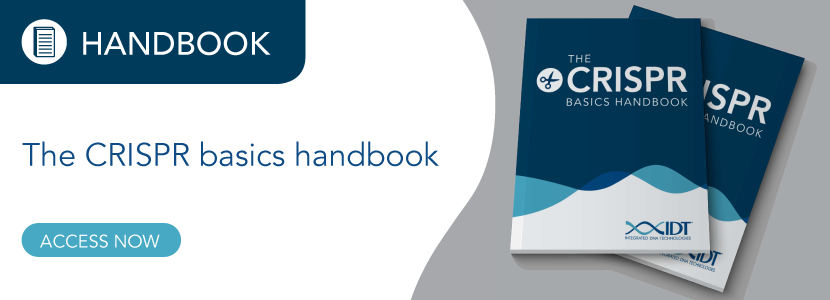In the last decade, CRISPR genome editing has greatly changed the way scientists approach biological problems. With CRISPR, it is now possible to change (edit) the genomic DNA sequence of any living organism. However, the technology can appear overwhelming for researchers who are new to genome editing. We prepared this CRISPR book to help beginners understand both the theoretical and practical aspects of CRISPR technology so that they can make this powerful tool a part of their research.
How The CRISPR Basics Handbook teaches you the basics
As explained in the handbook, CRISPR is easy to perform with what are now well-defined reagents―a CRISPR-associated (Cas) enzyme and a guide RNA (gRNA). The CRISPR basics handbook explains the functions of Cas enzymes and gRNA and describes how CRISPR works. Helpful explanations are given of non-homologous end-joining (NHEJ) and homology-directed recombination (HDR), both of which are used in CRISPR genome editing.
The CRISPR Basics Handbook provides step-by-step instructions on conducting CRISPR experiments for different research goals. Topics include how to design guide RNAs, how to disrupt a gene using CRISPR, how to correct a gene mutation, and descriptions of many CRISPR applications. There are discussions about CRISPRa and CRISPRi, as well as an explanation of how CRISPR components can be used in studies exploring nuclear organization and epigenetic modifications. Suggestions on how to choose between different kinds of Cas enzymes―from CRISPR-Cas12a to variants of CRISPR-Cas9, such as Cas9 nickases and dCas9―are also given.
Methods for delivery of CRISPR reagents to cells and appropriate use of controls are outlined. For researchers who need to use HDR in their CRISPR genome editing projects, details are provided on how to design HDR donor templates and choose enhancers. Finally, the CRISPR Basics Handbook dives into detail on the analysis of CRISPR-treated samples, how to determine if the desired edit has been accomplished, and importantly, how to analyze off-target effects.
Download our CRISPR Basics Handbook
The entire CRISPR Basics Handbook (PDF) is designed to be approachable. It will help researchers understand the “why and how” of each step in CRISPR genome editing― from experimental conception to data analysis―and especially help readers understand the many practical applications of CRISPR technology.Download your copy of The CRISPR Basics Handbook.
For research use only. Not for use in diagnostic procedures. Unless otherwise agreed to in writing, IDT does not intend these products to be used in clinical applications and does not warrant their fitness or suitability for any clinical diagnostic use. Purchaser is solely responsible for all decisions regarding the use of these products and any associated regulatory or legal obligations.
RUO22-1440_001


